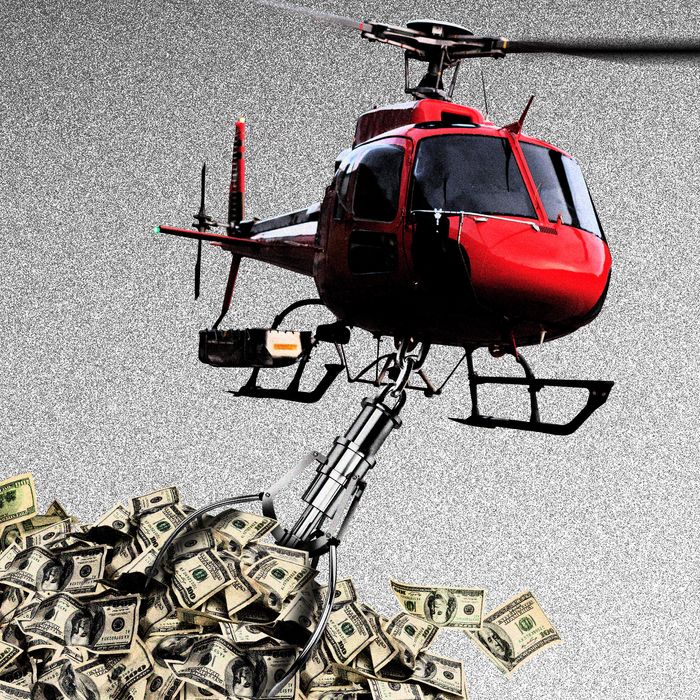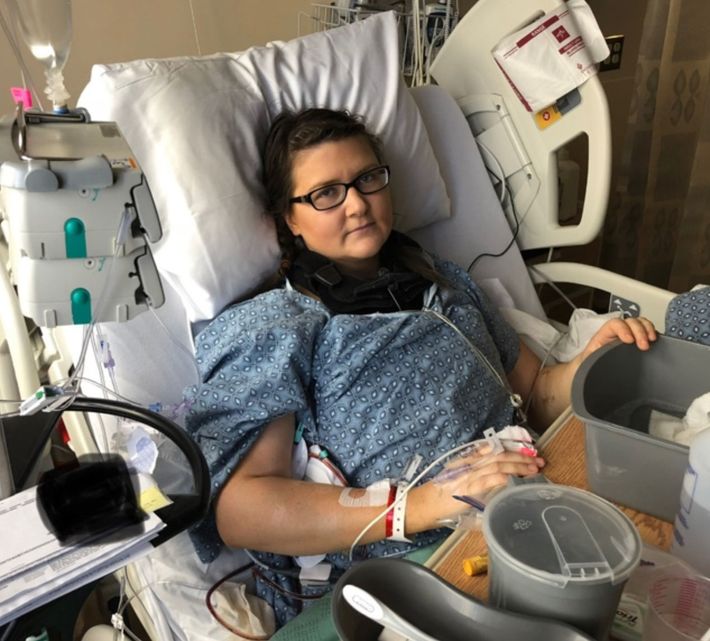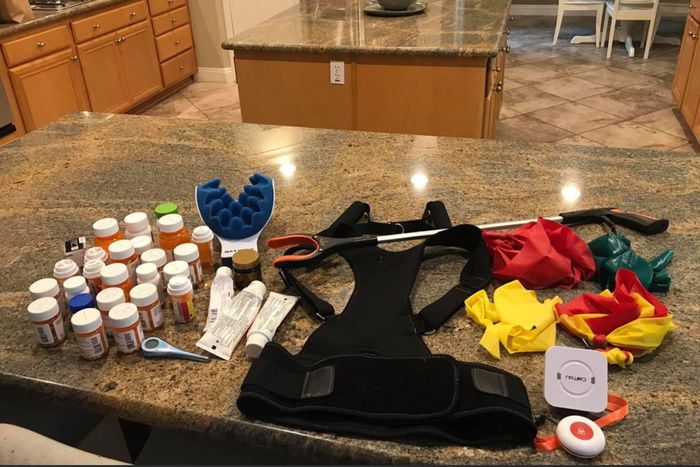
This article was featured in One Great Story, New York’s reading recommendation newsletter. Sign up here to get it nightly.
Kathleen Hoechlin was in the intensive-care unit, wondering if she would ever walk again, when she and her husband, Matt, started receiving the phone calls. It was January 2018, and the couple had just gone skiing in Mammoth Lakes, California. On the last run of the day, Kathleen skied over a small jump and landed on her back, shattering the L1 vertebra in her lower spine. With the nearest hospital ill equipped to handle the required surgery, she was loaded onto a small plane and flown 300 miles south over the Sierra Nevada mountain range to Loma Linda, where she underwent 12 hours of surgery to replace the vertebra with a metal implant. The phone call, which the Hoechlins received less than a day after the surgery, was from the air-ambulance provider, Guardian Flight, informing them that the plane ride had cost $97,269.
The couple tried not to panic, holding out hope that their insurance policy would cover the cost. But when the explanation of benefits finally arrived, it showed that Guardian Flight was out of network and that their policy would cover only $17,569, leaving the Hoechlins responsible for the remaining $79,700. Guardian Flight continued to hound them, with Kathleen not yet out of the full-body brace she was sent home in. “They were calling the week I got home,” she says. “I just told them, ‘How can you sleep at night? I can’t talk to you when you’re asking me for this money while I’m trying to learn to walk again.’”
From then on, Matt dealt with the incessant phone calls himself and managed to negotiate the remaining balance down to $20,000 after telling Guardian Flight that he and Kathleen would have to file for bankruptcy if it were any higher. Between their savings, gifts from family members, and a GoFundMe campaign, the Hoechlins managed to pay off the remainder. “It left me with a lot of trauma and a lot of ‘aha’ moments,” Kathleen says. “Why is this happening, and why should patients have to go through this?”
I first came across Kathleen’s story after being transported by an air ambulance myself last April, albeit under less severe circumstances. I was also on vacation in Mammoth Lakes when I experienced intense chest pain that was later diagnosed as myocarditis. After keeping me for a night at Mammoth Hospital, the staff there ordered that I be transferred via air ambulance to a medical center in Reno, Nevada, where a cardiology team could do the required testing. I pushed back initially, worried about the potential cost of the flight, but the doctors insisted it was necessary. Within a few hours, I was strapped to a gurney with tubes in my nose, flying over Lake Tahoe in a small plane while two paramedics sat nearby, ready to administer nitroglycerin in case my chest pain flared up again. The air-ambulance provider, REACH Air Medical Services, sent me a letter two months later saying the flight had cost me $86,184.
I spent the next eight months fending off letters and phone calls from REACH requesting full payment. Eventually, my employer intervened and got my insurance company, Cigna, to renegotiate with REACH, leaving me responsible for a co-pay of only $132 on the out-of-network claim. Even so, the experience left me with some of the same questions as Kathleen Hoechlin: Why is this happening, and how could something as essential as an air ambulance possibly be so expensive, especially when an estimated 550,000 patients in the U.S. require one each year? That line of questioning led to at least one culprit: private equity.
At the start of the aughts, private-equity firms conducted about $5 billion worth of deals in the U.S. health-care sector each year. By 2019, that figure had jumped to an estimated $120 billion, a result of deep-pocketed firms looking to park their money in a sector perceived as recessionproof (people get sick even when the economy is bad) and ripe for consolidation. When major private-equity firms started buying up air-ambulance companies, it set off a flurry of acquisitions. In 2010, Bain Capital bought Air Medical Group Holdings for $1 billion, only to sell it five years later for double that amount to KKR, which, in turn, merged the company with yet another air-ambulance provider, American Medical Response, under the name Global Medical Response. (Tracking this shell game can be dizzying. In the three years between Hoechlin’s air-ambulance flight and mine, Guardian Flight merged with REACH Air Medical Services; both are owned by Global Medical Response.) In 2017, American Securities drastically accelerated private equity’s takeover of the air-ambulance industry with its $2.5 billion purchase of Air Methods, the largest domestic provider of air ambulances. (In 2016, during its final year as a publicly traded company, Air Methods posted a $97.9 million profit on $1.17 billion in revenue, and the year before had paid its CEO $2.5 million in direct compensation, including stock options.) That purchase established the industry’s current landscape, in which two private-equity firms, American Securities and KKR, control almost two-thirds of the national market for air ambulances, according to Medicare data.
As private equity tightened its stranglehold on the industry, it jacked up the already-high prices. Between 2008 and 2017, the median price charged by providers for helicopter air ambulances nearly tripled, jumping from $12,500 to $35,900 per flight, according to a study by the Health Care Cost Institute. As the Hoechlins and I experienced, air-ambulance providers are often out of network with private insurance companies. That’s not by accident: Private-equity-backed and publicly traded air-ambulance providers in particular tend to remain out of network to charge higher rates than what may be allowed under an in-network contract. Since patients don’t decide when or where they have a medical emergency that requires them to be airlifted to a hospital, they don’t have a choice in which air-ambulance provider they use. As a result, competition in the marketplace does little to keep prices down — the higher providers set the price, the more they may be able to get paid. When insurers deem the cost too high, they pass the enormous remaining balance on to the patient, a practice known as “balance billing.” Among privately insured patients, an estimated two in five air-ambulance flights result in a potential balance bill. About half the time, though, the insurance companies simply pay up, according to Loren Adler, associate director of the USC-Brookings Schaeffer Initiative for Health Policy. Private equity “saw an opportunity to say, ‘Look, the existing companies aren’t leaning into the surprise-billing threat enough from a moneymaking perspective,’” says Adler, who co-authored a white paper last year about private equity’s impact on the air-ambulance industry. “If you really lean on that a lot, sometimes you can fight with the patient to get paid. But I think a bigger part of the money thing is often you can cajole the employer to pay because they don’t want their employee getting stuck with an $80,000 bill.”
Private-equity firms have applied their balance-billing approach to other corners of the health-care sector they have encroached upon, including emergency-physician staffing, anesthesia, and ground ambulances — all services for which patients don’t typically choose their providers. In 2017, Blackstone Group acquired the physician-staffing company TeamHealth for $6.1 billion, only to be one-upped a year later by KKR’s $9.9 billion purchase of another physician-staffing company, Envision Healthcare. In the time since, both companies have faced scrutiny for their aggressive billing practices, with TeamHealth sending thousands of surprise bills to patients in 2017 and even going so far as to sue low-income patients over unpaid medical debts. (The company now insists it has a “long-standing policy” against balance billing and ceased its practice of suing patients after a ProPublica investigation called attention to it in 2019.)
When asked about their exorbitant fees, representatives for air-ambulance providers tend to emphasize the high operational costs of the business. REACH, for example, says the company keeps its medical crews on standby 24/7. Other providers blame the costs they charge privately insured patients on the much lower reimbursements they’re forced to accept from people covered by Medicare and Medicaid, which, the providers argue, don’t come close to covering their operational costs. (Medicare often pays providers between $6,000 and $7,000 per fixed-wing air-ambulance flight, and those patients can’t be balance-billed by participating Medicare providers per federal law.) As a result, providers say they have to charge privately insured patients significantly more to compensate for the losses.
As air-ambulance providers continued to drive up their prices over the past decade, lawmakers started hearing from angry patients. Across the country, states attempted to rein in the industry, but air-ambulance providers shot down each attempt in court with an unlikely silver bullet: a 1978 federal law called the Airline Deregulation Act. Ironically, the ADA was designed to drive down the cost of air travel by deregulating the commercial airline industry and allowing it to function as a competitive free market. The nascent air-ambulance industry — which in 1978 consisted of a few dozen helicopters scattered across the country — was lumped in with commercial airlines under the broader category of air carriers, effectively preempting any efforts by states to regulate its prices. Time and again, air-ambulance providers invoked the law in court, successfully arguing that states did not have jurisdiction over the federally regulated industry.
The battle moved to the federal level, where patients finally started to gain traction. In 2017, the U.S. Government Accountability Office published a report on the growing concentration of the market before concluding that private equity’s increasing role in the industry “could further exacerbate these trends while also reducing transparency.” The following year, President Trump authorized the Federal Aviation Administration to create an advisory committee to research balance billing in the industry. The committee, which consisted of state insurance regulators, physicians, insurance executives, air-ambulance executives, and patient advocates, concluded last year that the federal government should consider increasing Medicare’s reimbursement rates to providers but that it should also remove air ambulances from the ADA’s protection.
In the meantime, Congress turned its attention to the broader issue of surprise medical billing, and the idea of banning the practice quickly gained bipartisan support. While air-ambulance bills are a comparatively niche concern, approximately one in five emergency-room visits results in a surprise medical bill of some sort, often stemming from a specific out-of-network service. (For instance, a patient may undergo a surgery covered by their insurance policy but unknowingly receive anesthesia from an out-of-network provider.) Having stumbled upon an issue that resonated with a wide swath of voters, both the House and Senate put forward bipartisan legislation in 2019 aimed at bringing an end to surprise medical bills for emergency care, inching the government closer to protecting patients from the air-ambulance industry’s skyrocketing rates. “I had heard horrific stories from people who, in a lifesaving emergency, had no idea that they were going to get some kind of surprise bill from an air ambulance,” says Senator Patty Murray, a Democrat from Washington who helped lead the Senate’s efforts to end surprise medical billing. “That was really critical for me to keep in the bill.”
Just as these efforts started to pick up momentum, a mysterious political-action group called Doctor Patient Unity dumped $28 million into an ad campaign aimed at derailing the legislation. The ads framed it as a unilateral victory for the insurance lobby, arguing that “government rate setting” would reduce patients’ access to care by leaving providers underfunded. In one of the ads, a suited man from “Big Insurance” shows up in a crowded waiting room and tells everyone to go home — he’s shutting down the hospital with a little help from Congress. Doctor Patient Unity operated in the shadows for weeks before a spokesperson put out a statement clarifying that the group was entirely funded by two private-equity-backed providers, TeamHealth and Envision Healthcare. Around the same time, Global Medical Response, the KKR-backed company that owns REACH, launched its own $800,000 ad campaign arguing that the legislation could force the provider to service fewer areas, leaving rural communities without emergency medical transport.
The ads couldn’t halt the legislation, and Congress passed the No Surprises Act in December 2020 as part of the second COVID stimulus package. The law went into effect this year and bans most surprise medical bills — with the notable exception of bills from ground ambulances. It also removes patients from the negotiation process between their insurance company and out-of-network providers, meaning patients shouldn’t receive constant phone calls as the Hoechlins and I did. Instead, patients will have to pay only the in-network rate dictated by their insurance policies, while providers and insurers negotiate the remainder of the cost between themselves. If they can’t agree on an amount, they enter an arbitration process overseen by the federal government, which has to be resolved within 30 days.
It may seem as if the battle to protect patients from shocking bills is over, but air-ambulance companies and other health-care providers aren’t giving up. A number of provider groups have sued the federal government, including the American Hospital Association, the American Medical Association, and the Association of Air Medical Services. While the lawsuits vary slightly, they all take issue with the arbitration process established under the No Surprises Act, arguing that it will result in insufficient payments to providers. (Research by USC’s Adler, by contrast, suggests that the only facilities that will suffer losses under the law “are those who were benefiting financially from surprise billing.”)
In the process of implementing the law, the Biden administration issued a rule instructing arbitrators to prioritize the median in-network rate for a service. In other words, if providers want to charge significantly more than that amount, they have to justify it to the arbitrator. Providers argue that this unfairly favors insurance companies. In an email, a representative from REACH said the company wants arbitrators to be “free to look at all the evidence and determine the appropriate out-of-network rate without influence from special-interest groups like the insurance lobby.”
While surprise medical billing will remain illegal no matter what, if the lawsuits succeed, providers might be able to once again charge insurance companies enormous fees for out-of-network services — a cost that could then be passed on to patients through increased insurance premiums. “This is their last-ditch effort to keep their profit-making billing mechanism in place,” says Patricia Kelmar, health-care campaigns director for the consumer-advocacy group U.S. PIRG. She points out that the No Surprises Act allows the federal government to collect data on the historically opaque air-ambulance industry, which will help regulators tweak the implementation of the law down the line. “It’s in no one’s interest to lose an emergency medical service, so there’ll be a lot of attention. And if there’s evidence to support that they can’t function in this market, providers will be the first to say it, as will the patients, and something will be done to change it.” In February, a federal judge in Texas ruled that the Biden administration had “impermissibly” altered the No Surprises Act by instructing arbitrators to prioritize the median in-network rate, and as a result, arbitrations were put on hold before they even began. Five provider lawsuits remain unresolved, but all eyes are now on the Biden administration, which is expected to issue its final guidance on the arbitration process by the end of May.
Despite previous bipartisan support for the No Surprises Act, the arbitration issue has since divided Congress. Last October, the top Democrat and top Republican on the House Ways and Means Committee co-wrote a letter accusing the Biden administration of undermining Congress’s intent by “tipping the scales” of the arbitration process. The Democrat, Representative Richard Neal, told me the administration needs to “implement a fair system of dispute resolution for health-care providers and insurance companies that doesn’t have negative downstream impacts on patients.” Subsequently, 150 representatives in the House — split roughly evenly between Democrats and Republicans — issued a similar letter, as did a separate group of Republican senators. Despite pressure from providers, other lawmakers haven’t bent, including Senator Murray and Representative Frank Pallone, who co-authored the original House legislation and believes the Biden administration’s interpretation of it is consistent with congressional intent. “I’m very concerned that the outcome could lead to hospitals and insurance companies shifting more and more costs onto consumers,” Pallone, a Democrat from New Jersey, said in a statement about the lawsuits. “It’s just another unfortunate example of financial greed, and I’m hopeful that the courts do the right thing and that the administration can ultimately implement a policy that keeps costs down for consumers.”
As providers and insurers continue fighting among themselves over who gets to keep the bigger share of the profits when someone needs emergency care, patients such as Kathleen Hoechlin are being left out of it. “You know, my life was saved by that air ambulance,” said Hoechlin, who has since gotten certified as a patient advocate to help others navigate their insurance battles in her free time. “And I’m so grateful for the crew and everything. They deserve to be paid — but a fair amount.”
































